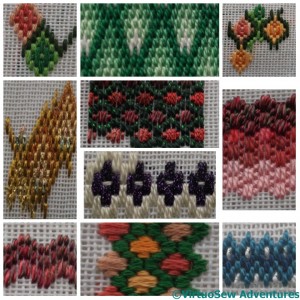
Testing Canvaswork Patterns
While I am still trying to work out how to do the Chorus of Angels, I’ve decided to work a single Angel from the Chorus in an entirely different medium – needlepoint. The original idea was to have it done by Christmas, but I’m becoming aware that that isn’t very likely now.
Once I’d made that decision I had a lot of fun playing with bargello patterns and trying to choose something suitable. I’m using a fine canvas – 18 count, I think, although as it came, unlabeled, in among that collection of supplies that included several frames, I’m not sure. It’s full of size and is going to be rather a trial to stitch, I fear.
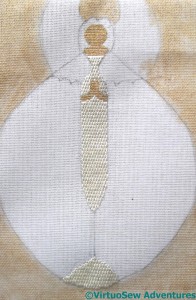
Gown Done
I’ve decided to use the gold pattern on the far left (slightly altered) for the background, to give an effect a little like the patterned gold background of an icon. The lines of this panel are so simple that I can afford to use some quite complicated patterns, I think.
In the end I settled on the green and red spots in the upper middle for the cape, although choosing the colours hasn’t been quite straightforward. The wings are still puzzling me.
Since I have decided on a gold background for the angel, I decided to paint the background canvas gold as well. That will help to boost any thin coverage.
I’ve worked the gown underneath the cape very simply, in cream brick stitch, and the face and hands using gold tent stitch. None of the variants of flesh colour seemed right, and the gold does at least belong in the design.
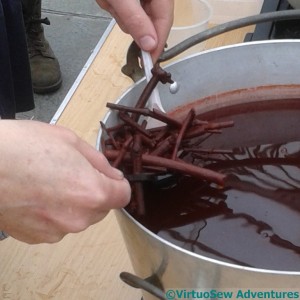
Madder Root
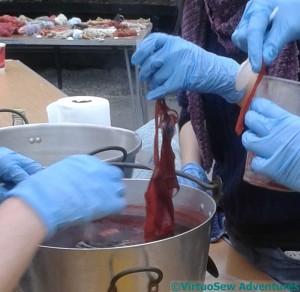
Out Of The Bath
I did study the techniques of dyeing and printing during my degree course, but that was industrial printing and dyeing, on a vast scale and using chemical dyes. Using natural dyes and working on a smaller scale will be a whole new adventure. It isn’t as consistent, but then that is the charm of it.
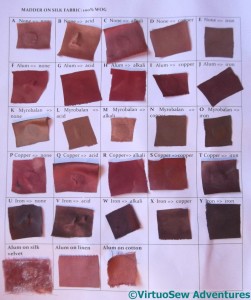
25 Shades of Madder On Silk
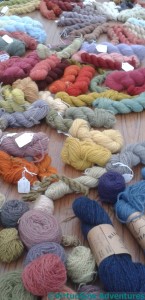
A Welter of Wonderful Wool
So off I went, rummaging through the interwebs for an introduction to natural dyeing and finally found it via Twitter, in a workshop entitled “Twenty Five Shades Of Madder” in the Glasgow Botanic Gardens given by Julia Billings of Woollenflower. It was fascinating, and gave me much to think about.
Mind you, I might have given Julia and all the other lovely ladies on the course something to think about as well, because I had my quotation from Pliny in my notebook to explain what an embroiderer was doing at a workshop, run by a knitter and attended largely by knitters.
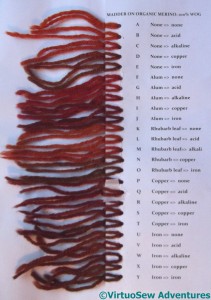
25 Shades of Madder On Wool
It did more than explain – everyone’s imagination went into overdrive! The idea of multicoloured fabric coming out of a single dyebath clearly enchants everyone, not just me!
We even had a walk through the Gardens looking for plants that yield dyes. There are a lot of them – more than you might think!, and mordants (pre-dyebath treatments) and modifiers (post-dyebath treatments) make a lot of difference as well.
So now, I have a list of books and DVDs to look at, and suggestions of other people to get in contact with or research – and someone to ask for help if it all gets too much (thanks, Jules!)
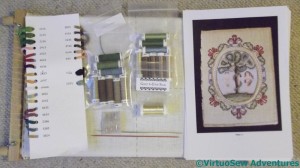
Garden Of Eden Kit
There’s another Thistle Threads course starting, a book cover called “Eve In The Garden Of Eden“, and I was highly intrigued by it.
I was even more intrigued by two of the items that came with the first kit. They look rather like double ended knitting needles, but the picture doesn’t seem to included anything knitted. The kit also includes an assortment of gimps, a gold thread, and a wonderful selection of silk floss. I’ve fallen in love with silk thread since I started following Tricia’s courses, and while I still find uses for my cotton, linen, and wool, silk is always a treat.
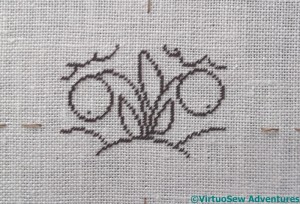
Getting Started
The first stage is all in tent stitch. The fabric is 30 count, which is fine enough to that I have been using both my goosenecked magnifier, and my magnifying glasses. This is the central panel of the spine. I’ve decided to enlarge the chart before I do any of the colour stitches, because the chart is a bit small, but I’m rather pleased with it so far.
I’m going to try to keep up with this course, because I’ve just seen that there is a Stumpwork Lion course being planned, and he looks wonderful!
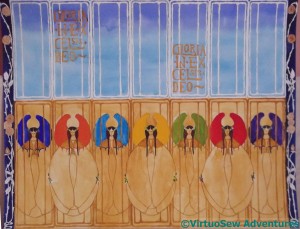
Chorus Of Angels
My mother and I have been planning a backdrop for some crib figures I inherited some years ago from a great aunt.
We started off by thinking about a stylised landscape (I might still do that one of these days), and then we thought about some sort of embroidered “stable” (likewise!), but none of the ideas really came together.
The crib figures are simple, and carved in wood, and we think they were bought in Germany after the war. We think that simplicity might be best set off by something really gorgeous and colourful, so then my mother designed a chorus of angels inspired by the “May Queen” design by Margaret Macdonald Mackintosh. She substantially simplified the basic design, added wings and then created two ranks of singing angels.
She’s also created a wonderful top panel of graduated blues and superimposed the text “Gloria in excelsis Deo” over the top. At the moment we are thinking about creating an ombré dyed section for the graduated panel, and couching gold and silver threads to make the framework. Then maybe using golden gauze for the lower panel, using a second layer for the capes.
As for the wings – well, detached buttonhole stitch, perhaps? Maybe in Gilt Sylke Twist, if I can get the right colours. I’m torn between a rainbow of colours, as my mother has painted them, or some other selection. Really, it will depend on what takes my eye when I get to that stage!
We want to work it on silk, and I want to be a bit clearer about what I’m doing before I get started. So it won’t be done in time for this Christmas.
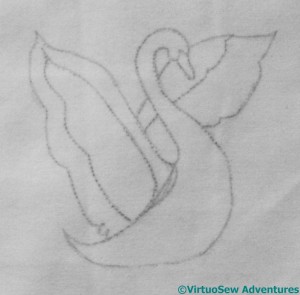
The Swan
The Swan is a much simplified rendition of a photographed one. I decided in the end to change the lines on the nearer wing, so it more clearly grows from the body of the bird, but one of the great advantages of laid and couched work is that it covers such infelicities of drafting – just so long as you remember to ignore the lines that you had decided to ignore (if you follow me…)!
It still looks a little too naturalistic, but the colours will help (blues and purples, like the Unicorn). I will have to work out suitable embellishments for the wings in due course, as well, and that will also help. As it happens, the layer of laid and couched work gave me quite enough trouble!
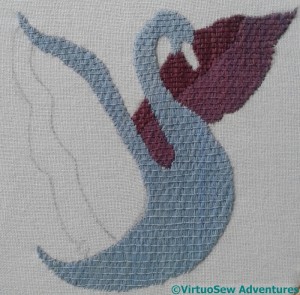
Swan Progress
I wanted to work the body in the pale blue, to maintain at least some link with the real thing (after all, shadows on white often look blue…).
That made it possible to make sure that I reminded myself to include the forward edge of the nearest wing in with the body.
Then the more distant wing clearly had to be in purples as being more distant and helping to throw the body forward visually. And then I came to a grinding halt – which may explain why you haven’t seen the wretched thing.
I enjoy the technique enormously, but it’s taken me all summer to ignore it and clear my head of colour schemes I hated, come back to it, and try again.

Egyptian Patterns
When I was working on my Master’s Degree, I came across this reference to dyeing in Egypt, as described by Pliny the Elder in his “Natural History”:
In Egypt, too, they employ a very remarkable process for the colouring of tissues. After pressing the material, which is white at first, they saturate it, not with colours, but with mordants that are calculated to absorb colour. This done, the tissues, still unchanged in appearance, are plunged into a cauldron of boiling dye, and are removed the next moment fully coloured.
It is a singular fact, too, that although the dye in the pan is of one uniform colour, the material when taken out of it is of various colours, according to the nature of the mordants that have been respectively applied to it: these colours, too, will never wash out.
Thus the dye-pan, which under ordinary circumstances, no doubt, would have made but one colour of several, if coloured tissues had been put into it, is here made to yield several colours from a single dye. At the same moment that it dyes the tissues, it boils in the colour; and it is the fact, that material which has been thus submitted to the action of fire becomes stouter and more serviceable for wear, than it would have been if it had not been subjected to the process.
Pliny the Elder, The Natural History, Book 35, Chap.42
Now, Pliny the Elder was writing long after Akhenaten’s time, indeed after Egypt became part of the Roman Empire, but plant dyes were already known in 18th Dynasty Egypt, so I am going to assume that mordanting was also known.
I simply have to try this!
I’m not going to try to use Egyptian plant dyes – I think it will be quite challenging enough as it is – but I need to do some research to discover what colours can be obtained by different mordants from a single dyestuff, then work out how to apply the mordant in patterns in such a way as to ensure that it works.
And then do it. It would make a fabulous video, wouldn’t it, dipping a white cloth into a vat and getting multicoloured cloth out again!
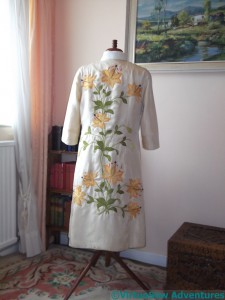
Tiger Lilies – Long View
This rather fabulous coat was a collaboration. My mother made it for herself to wear at a friend’s wedding in the early nineteen-sixties, and when she began to run out of time, Grandmama stepped in and stitched like a whirlwind to get it finished!
The original outfit was a silk dress and coat combination, a very simple sheath dress, and this edge-to-edge, three-quarter sleeve coat. The front is completely unadorned, because, after all, at a Church wedding people will mostly see each other from the back!
The design of Tiger Lilies is from a transfer. Actually, we think it was three of the same transfer, cut and put together to create a design that fit the coat back. After the darts had been put in…

Tiger Lilies – A Flower
I’ve seen a few cream running stitches which suggest to me that, rather than using the transfers as transfers, the design was stitched through the paper. Given the sensitivities of silk, that was probably very sensible!
The embroidery is worked in stranded cotton. It’s all very simple stitchery, long and short stitch, stem stitch, French Knots, and a few buttonhole wheels.
It relies for its effect not on complexity of stitching, but on the colour and pattern combination.
If I’m going to be picky, the silk was a bit light for the stitching – although the puckers may be a result of years and cleaning, as I can’t imagine Grandmama, after Miss Hunter’s training, would have stitched with such tension, and no more would my mother, after Grandmama’s training!
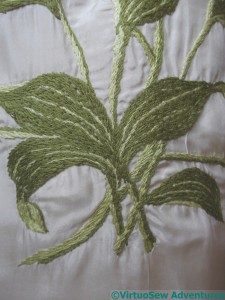
Tiger Lilies – Leaves
Grandmama also contributed assistance in making a pillbox hat, ornamented with swirls of gauze to match the colours, and then they painted a pair of shoes (Rayne, no less!) and a handbag (Marks and Spencer, alas) to match the green gloves which were bought new. A three-strand green stone bead necklace completed the outfit, and my mother remembers receiving a lot of compliments, at that occasion, and several others later.
Many years later still, when I was in the Upper Sixth, with a pale orange sheath dress underneath, I wore this for the Founders Day Service at school. We went into town afterwards, and my goodness, how people jumped to serve us!
Regrettably the coat fits neither my mother nor myself these days, and we’re wondering what to do with it…
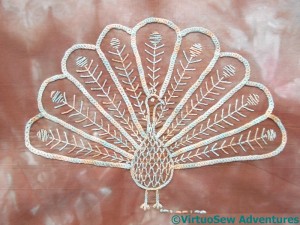
Fine Feathers
Some time ago, I worked on a few designs vaguely inspired by crewelwork, which I submitted to a few companies, none of whom took them. I hadn’t stitched any of them, because I would have used the preferred thread of the company that intended to produce them, but I’ve wanted to…
So when I had another hiatus of inspiration with the Dreams of Amarna, I rummaged for a thread that would work nicely with this over dyed fabric, and had a go. When I originally planned this design, I used peacock colours – blue and green, but I felt that it would be more interesting to work with a single, overdyed thread on the overdyed fabric.
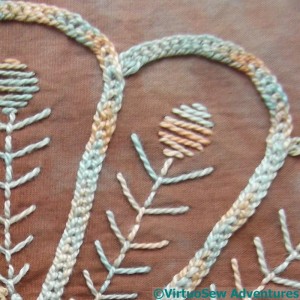
Fine Feathers – Detail
I chose to use Hungarian Plaited Braid stitch for most of the outline. The more I use this stitch, the more I like it. It’s richly textured but at the same time creates a fairly smooth effect, and while – as in this case – it works beautifully in a perlé type thread, it can be very successful, if a little trickier to work, in stranded cotton.
Fly stitch alternating with back stitch gives a bit of lightness to the tail feathers, and I borrowed the idea of the dragon’s scales from Kai Lung of the Golden Hours to create the effect of the down on the peacock’s breast.
I’ve signed him – the Morse code by his feet – but now I’m not at all sure what to do with him!
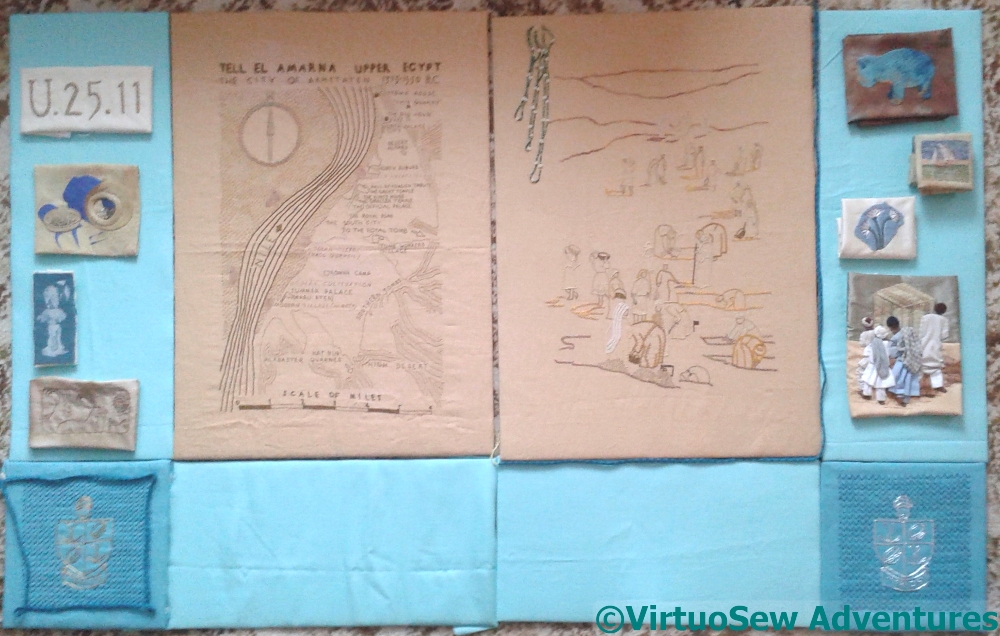
Layout Trial
Once I’d finished the View of the Excavation, I thought it would be a good idea to see whether the whole Dreams of Amarna project was even remotely on the right track, so I got some mount board cut, and taped the Map and the Excavation around their boards, the two Crests around theirs, and then cut some of the pale turquoise linen for the rectangles around the edge. Then I burrowed into my box of the finished patches and bits – including a couple of yards of kumihimo braid and some beading – and started trying to arrange them to see whether it was going to work.

Panel One
I think it may be working! The colour blocks work beautifully, although the arrangement of the patches I arrived at for the picture above is better than the one in these.
I need to find somewhere else to use the purple-blue of the shadow on the Crock of Gold patch, and the dark fabric behind the Faience Hippotamus.
The Kumihimo braid was intended to frame the Crest for the Dig panels, but I think it works better in the second panel when I used it to edge the Excavation. So I guess I have to braid some more!
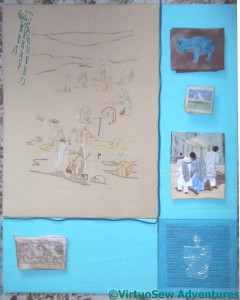
Panel Two
I do think I need to put some texture in to the background of the Excavation. It will help to balance the texture in the Map, and it will create a bit more variation in colour.
Loading the Felucca looks good, and makes a great punctuation mark. The Daisy Beads – well, that’s not the final arrangement – I just need to work out what will be.
And I need to go back to my notebook of ideas, and pick some more patches to do.
However, I do think it is going to look good.
Eventually!
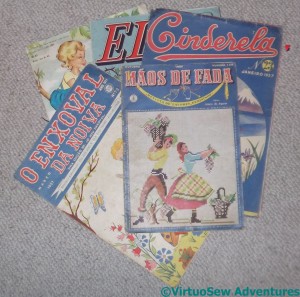
Portuguese Patterns
Recently we had a visit from some Portuguese friends, who we last saw when we were in the Azores. They had obviously remembered my delight when I found the embroidery shop in the main square at Punta Delgarda, because for their hostess gift, as well as bringing some coffee and olive oil, they brought a set of vintage Portuguese sewing and embroidery patterns!
Although they look like magazines, each one is in fact a large sheet that unfolds to provide drawn-out patterns for a multitude of types of embroidery, including surface embroidery, appliqué, cutwork and drawn thread work, some of it crisp and simple, some of it bright, colourful and really quite ornate. Suggested applications for the designs appear as well, so next time my inspiration flags (er, and I’ve finished the Azorean Cutwork!), I will be able to leaf through these to refresh it!
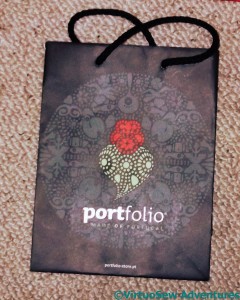
Another Pattern
The coffee was presented in this paper bag, which is printed with a design that our friends told us is inspired by a traditional embroidery pattern from northern Portugal. They said they were disappointed not to have found some embroidery for me, but in some ways, I think this is even better.
One of these days I will be able to play with this design, and maybe reinterpret this traditional style in my own way.
I’m looking forward to that!























